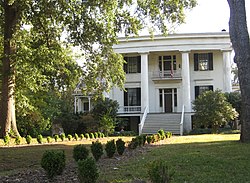Robert Toombs House State Historic Site
Robert Toombs House | |
 | |
| Location | 216 E. Robert Toombs Ave., Washington, Georgia |
|---|---|
| Built | 1797 |
| Architect | Unknown |
| Architectural style | Greek Revival, Federal |
| NRHP reference No. | 72000410 |
| Significant dates | |
| Added to NRHP | April 11, 1972[1] |
| Designated NHL | November 7, 1973[2] |
The Robert Toombs House Historic Site is a state historic site at 216 East Robert Toombs Avenue in Washington, Georgia. It was the home of Robert Toombs (1810-85), who was a pro-Union U.S. representative and U.S. senator, and then a Confederate general and Confederate secretary of state during the American Civil War. Operated as a state historic site, the 19th-century period historic house museum also features exhibits about the life of Toombs. The house was declared a National Historic Landmark in 1973.[2][3]
Description and history
The Toombs House is located on the east side of Washington, on the south side of East Robert Toombs Avenue. It is a two story wood frame structure, fronted by a two-story colonnade of fluted Doric columns. Its main entrance is flanked by sidelight windows and topped by a transom. The interior of the house has been decorated to reflect its mid-19th century occupation by Robert Toombs, and includes his private library. The house was built sometime between 1794 and 1801 by Doctor Joel Abbott, and was acquired in 1837 by Toombs. Toombs is credited with a number of alterations, including the front colonnade and the west wing.[3]
Robert Toombs was one of the American South's prominent pre-Civil War orators. Although he supported the extension of slavery into the territories, he also opposed the breakup of the country, and was a major supporter of the Compromise of 1850. When the American Civil War began in 1861, he became the Confederate States of America's Secretary of State, but resigned over differences with President Jefferson Davis, and entered the Confederate Army. He fled the country at the end of the war, eventually returning to a successful law practice.[3]
See also
- List of National Historic Landmarks in Georgia (U.S. state)
- National Register of Historic Places listings in Wilkes County, Georgia
References
- ^ "National Register Information System". National Register of Historic Places. National Park Service. January 23, 2007.
- ^ a b "Robert Toombs House". National Historic Landmark summary listing. National Park Service. Retrieved 2008-04-30.
- ^ a b c Benjamin Levy (January 13, 1973). "National Register of Historic Places Inventory-Nomination: Robert Toombs House" (Document). National Park Service.
{{cite document}}: Unknown parameter|format=ignored (help); Unknown parameter|url=ignored (help) and Template:PDFlink
External links
- Official website
- Get Outdoors Georgia - Robert Toombs House Historic Site
- Historic American Buildings Survey (HABS) No. GA-13, "Robert Toombs House, Washington, Wilkes County, GA", 2 photos, 3 data pages, supplemental material
- National Historic Landmarks in Georgia (U.S. state)
- Historic American Buildings Survey in Georgia (U.S. state)
- Houses in Wilkes County, Georgia
- Houses completed in 1797
- State parks of Georgia (U.S. state)
- Historic house museums in Georgia (U.S. state)
- Biographical museums in Georgia (U.S. state)
- Museums in Wilkes County, Georgia
- Protected areas established in 1972
- Houses on the National Register of Historic Places in Georgia (U.S. state)

